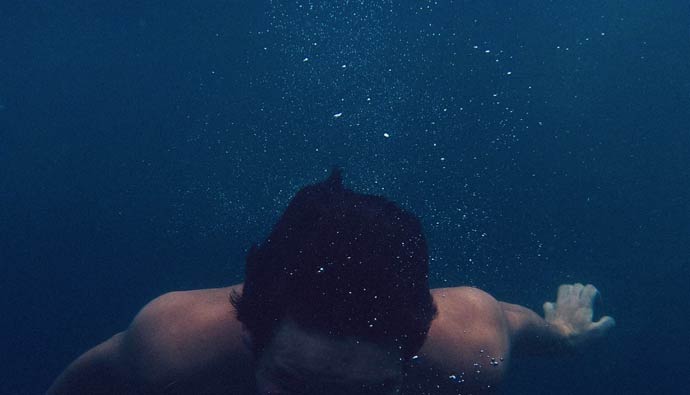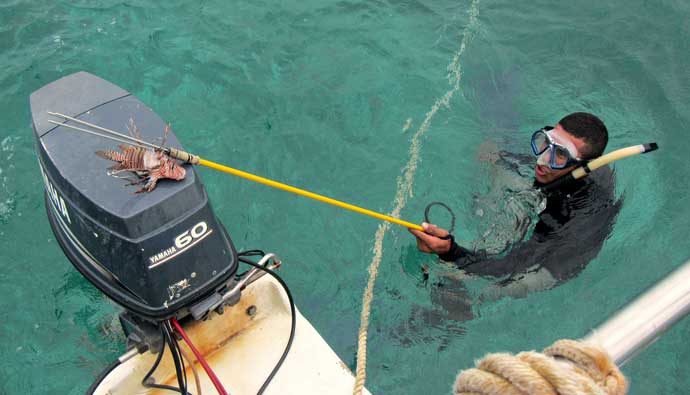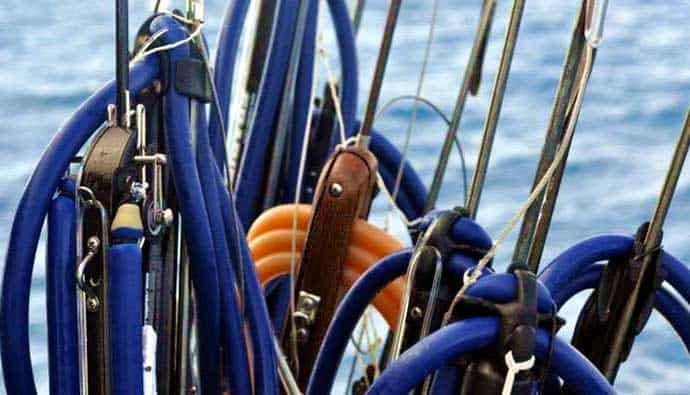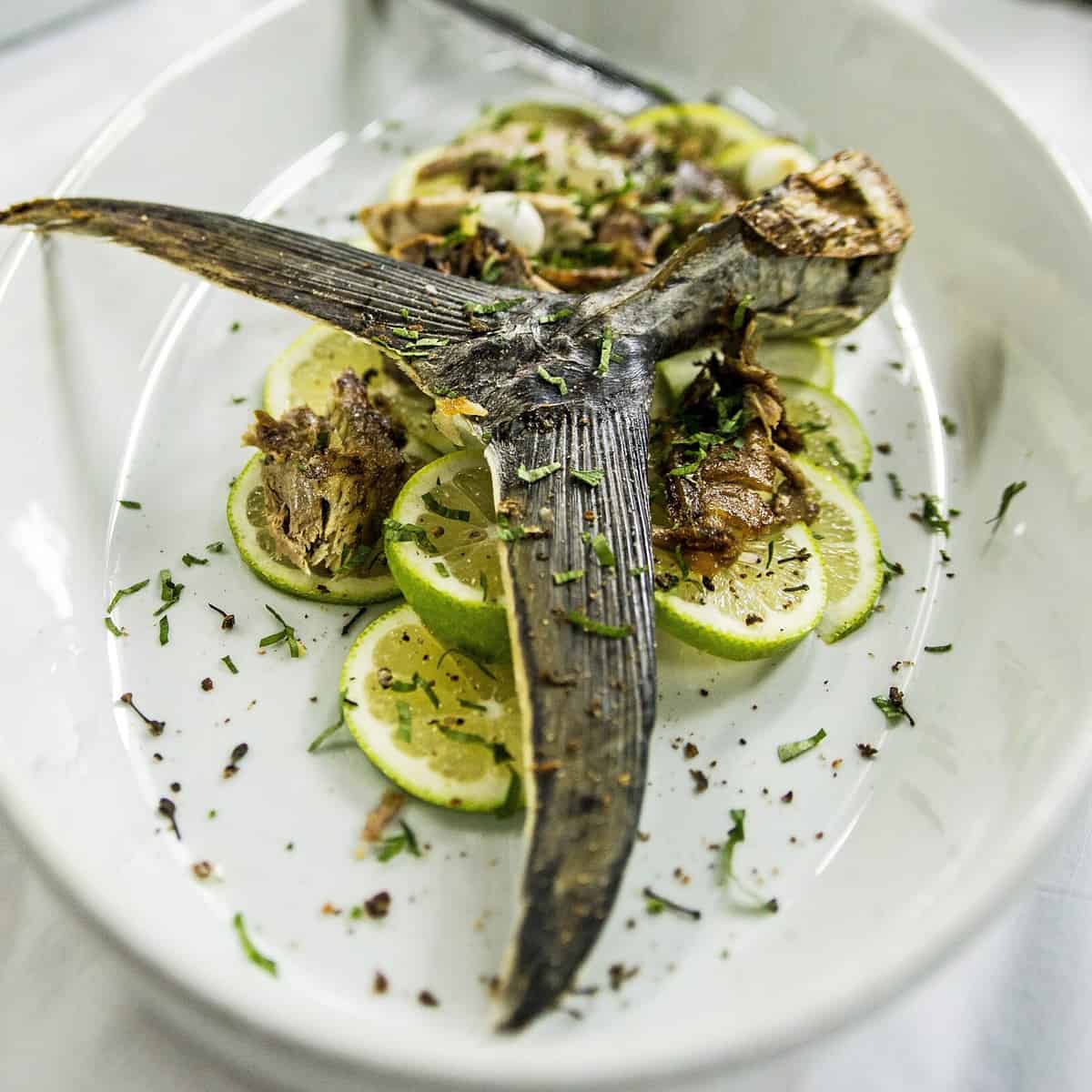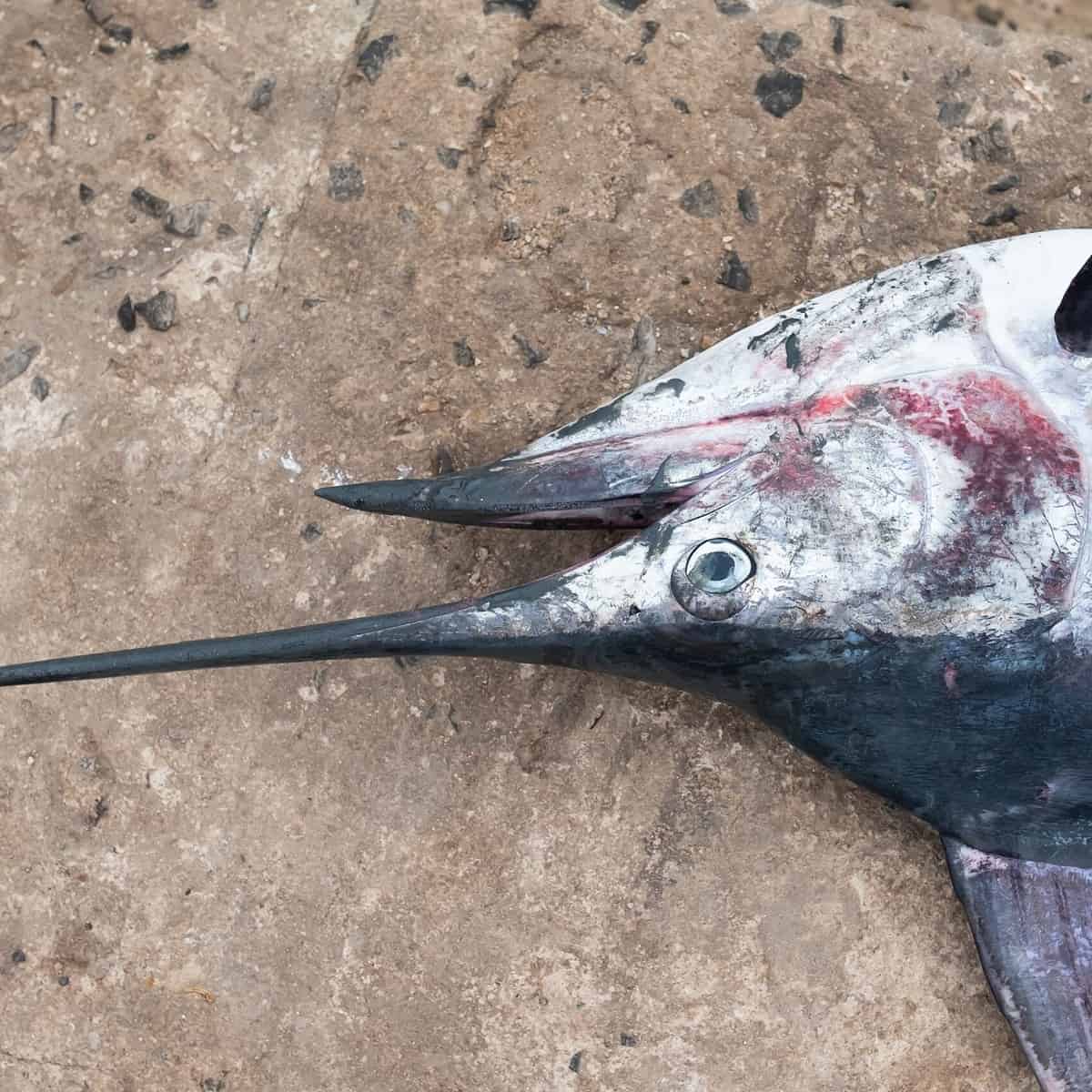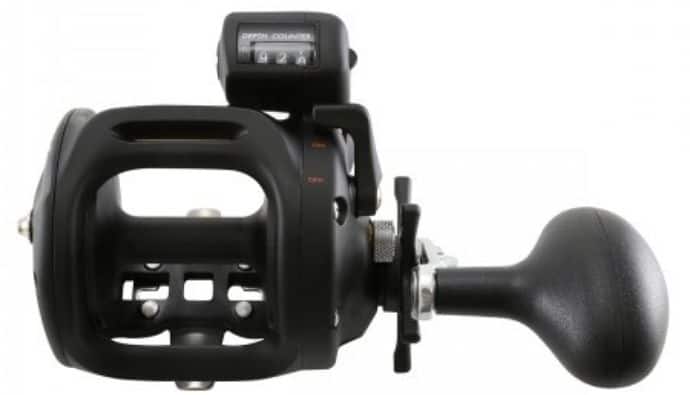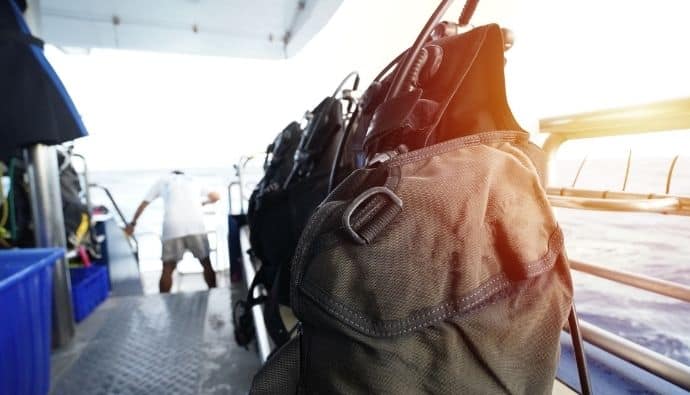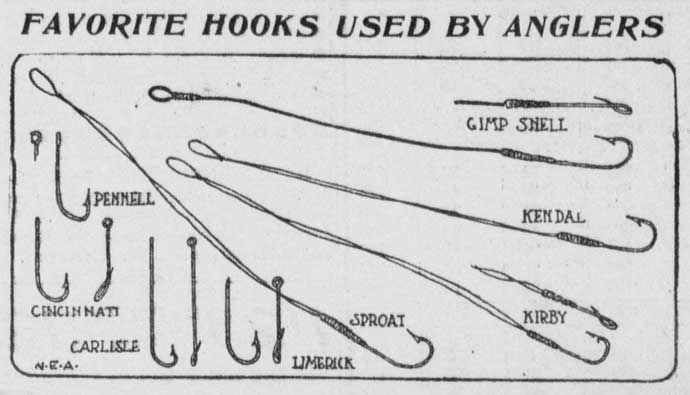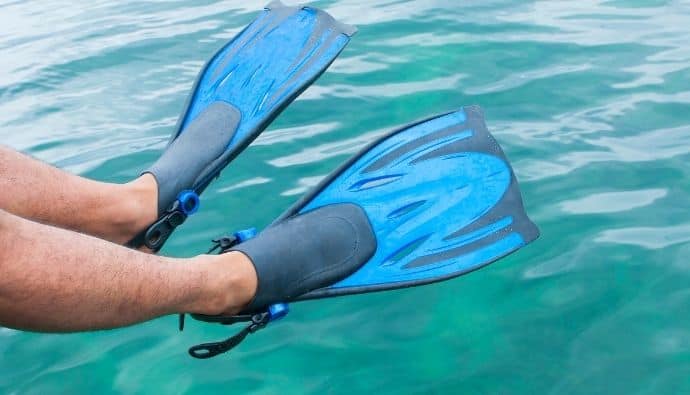We love the best pole spears and have tried most of them out down in Baja. Since we know some of the manufacturers, we’ve been able to work out exclusive Cast & Spear-only specials that we hope you enjoy!
Top Pole Spears
Listen to more spearfishing on the Cast & Spear Podcast
7 Best Pole Spears for 2023 Reviewed
- Best Pole Spear – Eight’er Gatku Pole Spear (Use Promo code: JonCastandSpear)
- Most Powerful – Crist Neptune (Use Promo code: JonCastandSpear)
- Best Budget Pole Spear – Mako Spearfishing Traveler Pole Spear
- Best Travel Pole Spear – Gatku Eight’er 3 Piece (Use Promo code: JonCastandSpear)
- Best Carbon Fiber Pole Spear – Evolve Carbon Fiber Pole Spear
- Best Custom Pole Spears – Linghunt Custom Pole Spears
- Most Lightweight Pole Spear – JBL Shaka Polespear
1. Eight’er Gatku Pole Spear
Best Pole Spear
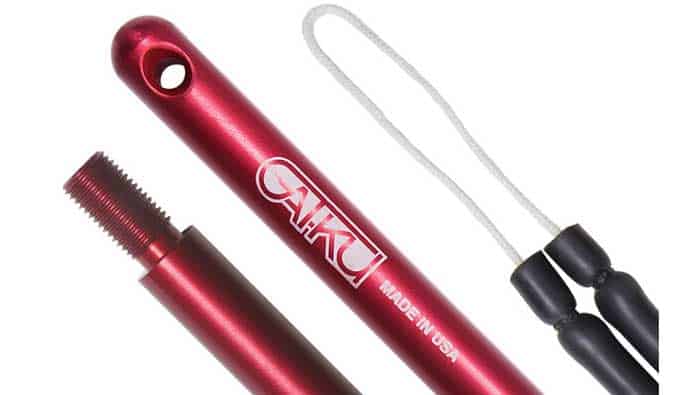
This pole spear is more for experienced divers.
It’s the perfect weapon for the Bahamas. Go after Hog Fish, Snapper, Grouper, and all the small stuff too when coupled with their InshoreShrinker. Also acceptable for pelagic fish if you use their Slip Tip.
This pole spear is a sleek, 3/8” diameter, carbon graphite front end that allows you to effortlessly swing polespear with minimized drag in the water; This is especially a benefit when tracking fish.
The extended section in front of the loaded hand allows you to see where the polespear is headed. Eliminating the ‘shooting from the hip factor. Instead, you are capable of pinpointing targets with limited guesswork.
This polespear won’t feel so ‘weighted down’ in the rear with the tip 3’ away from the loaded hand; resulting in natural tracking movements plus a more comfortable hold.
With 3’ of polespear in front of your extended, loaded hand, fish are much more approachable. The proximity of your body and the fish is a greater distance, making it less likely spooked.
This is another pole spear brand that comes highly recommended by nearly all spearos!
Use code “JonCastandSpear” for a free dive knife, extra band, keychain, and stickers
Check out our Gatku Pole Spear Review
2. Crist Neptune
Most Powerful
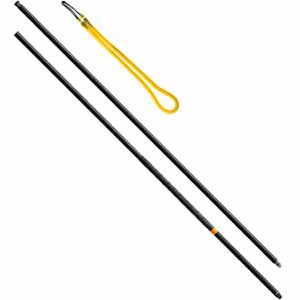
Crist is considered the Mack truck of pole spears. They are a heavy-duty beast that will deliver a punch that will knock a fish on its fins.
Just note that with this power comes added stress and strain on your arm and joints. It’s not a polespear that will leave you feeling refreshed at the end of the day. But, if you need a pole spear that will penetrate the thickest fish armor, then you should try one of these. They come in various sizes. We prefer the 8-foot Neptune.

Use code “JonCastandSpear” for a free dive knife, extra band, keychain, and stickers
3. Mako Spearfishing Traveler Pole Spear
Best Budget Pole Spear
The MAKO Spearguns 3-in-1 Spearfishing Traveler Pole Spear is perfect for small to medium size fish and perfect for travel.
Capable of taking fish weighing as much as 10 to 15 lbs, this 3-piece design measures a whopping 6′ 7″ and breaks down to only 27.5″ long for easy storage and travel and allows you to configure the length to your specific needs.
3 pieces: 6′ 7″ long for normal hunting conditions 2 pieces: 4′ 5″ or 4′ 11″ long for close-range hunting and Lion Fish hunting 1 piece: 33″ inches long strictly for killing Lion Fish.
Mako uses high-strength, corrosion-resistant, anodized aircraft aluminum spears which will NEVER yield painful fiberglass splinters in the hand (like some inexpensive fiberglass pole spears do when worn down).
Connection Joints
The connecting joints are supported by recessed flush screw-on connectors for a smooth release. Includes Three interchangeable sections for 3 different pole spear lengths. One 5-prong cluster (paralyzer tip) with “sure grip” barbs on each prong. One full-length MAKO “Latex Power Band” for 3 pc and 2 pc hunting.
NOTE: There is no knurling in the grip area. This is typically not a problem when gripping with bare hands. However, if you like to wear gloves, Mako recommends you check out their “Orange Honeycomb Super Grip Gloves” or “Latex coated Lionfish Gloves”. Combining these gloves will give you the warmth and the grip you need.
4. Gatku Eight’er 3 Piece
Best Travel Pole Spear
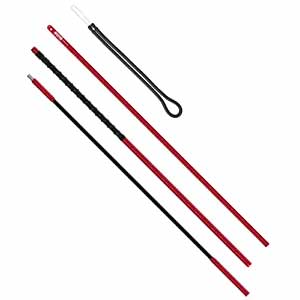
Much like the two-piece Gatku Eight’er, this pole spear actually has a bit more rigidity and can be broken down to fit inside your luggage.
The nice thing to do is that if you want you can put the mid-section extender onto any other Gatku to make it longer which is an added bonus for keeping your arsenal within one brand.
If you’re going on a long trip and want to bring a quality pole spear with you then go with this. Why isn’t it ranked higher than? It’s a bit more pricy than other options so for the beginner it can hurt the wallet a bit.
Use code “JonCastandSpear” for a free dive knife, extra band, keychain, and stickers
5. Evolve Carbon Fiber Pole Spear
Best Carbon Fiber Pole Spear
This pole spear is the pride of Hawaii! You can break down these Carbon polespears and transform it into 5 different lengths.
This pole spear is produced using spaceship grade high strength T700 Carbon along with a solid core. It also uses high tolerance 7075-T6 Aircraft Aluminum fittings.
Available in 4 sizes, CT6 – 6′, CT7 – 7′, CT8 – 8′, and CT9 – 9′, and can transform into 4-8 different combinations!
If you are looking for what the locals use…you’ve found it!
6. Linghunt Custom Pole Spears
Best Custom Pole Spears
Sometimes a bulk-manufactured pole spear won’t get the job done. That’s why I recommend you also check out Linghunt Engineering. They are known for letting you specify every aspect of your dream pole spear.
LEI is a small engineering business specializing in the custom design and manufacturing of high-quality items ranging from Industrial Controls to Spearfishing and Hunting.
When in doubt, build it yourself!
7. JBL Shaka Polespear
Most Lightweight Pole Spear
If you’re looking for a stiff carbon fiber pole spear that you can take with you on your next trip to the islands, then check out the JBL Shaka.
This pole spear is lightweight and will fit right in your luggage without a problem. For the metal components, they do use aluminum aircraft-grade aluminum which won’t corrode in salt water.
It’s a bit on the pricier side, but JBL has been around for a long time in the spearfishing industry, so you have their brand name backing up this product.
Why Do You Need the Best Pole Spear?
Hunting fish using a pole spear has been around for hundreds of years. There is no better way to get a better understanding of the sport than to try getting close to a fish and piercing them with a simple pole spear, wetsuit, and mask.
Bill Rogers, who’s been spearfishing for over 40 years, even states that predatory fish understand aggression. Therefore they tend to stay away from a spearo with a carbon fiber speargun because they can sense they are being stalked prior to an attack.
With a pole spear, however, the slim profile can be concealed by the diver until the last second and surprise the fish at close range.
Let’s dive into other benefits of the pole spear.
Cost of Pole Spear vs. Speargun
The cost of pole spears is significantly cheaper than a speargun. The entry-level speargun will cost around $150 dollars, but that doesn’t include all of the added extras one needs to effectively shoot decent size fish.
However, with a pole spear, you can get the basic entry-level yellow fiberglass model for around $35…although I would not recommend that version as they don’t last long. A pole spear you’ll be happy with will cost around $80 and will last you years.
That’s still nearly HALF THE PRICE of a basic speargun!
Ease of Use
A pole spear is quite simple to use as long as you have decent arm strength. The hardest part for most people when getting started is to load the rubber band and have enough grip strength to hold the handle while waiting to shoot a fish.
However, higher-end models have an S-clip that holds the loaded band in place until you find the fish he wants to attack. You can then disengage the S-clip and release your grip to fire.
The huge benefit comes after shooting your pole spear…there is no complex reloading. Many times when you use a speargun, you’ll have the extra line from your reel or wrap that you’ll need to deal with to reload the gun.
This takes time, especially for a new spearo, and can be quite frustrating. It’s even harder if you have a fish on the end of your spear trying to swim away…none of this matters with a pole spear.
Shoot Multiple Fish
When you go down in search of fish in the reef or caves, after you take a fish with a speargun, you almost always need to come up for breath to unload the fish and reload the gun.
With a pole spear, depending on how much air you have in your lungs and the size of the fish you’re spearing, you could actually take multiple fish in one breath.
This is beneficial because sometimes fish are gathered together and easy to take at one time. Many spearos lose sight of fish when they go up for a breath and try to head back to a good spot.
A lot of times, fish tend to move from place to place, and if you can’t keep an eye on their movement, you’ll lose them.
Safer Than Spearguns
When you’re using a speargun, you’re using a gun. Guns are typically powerful and also have moving components that can misfire, such as the trigger mechanism.
Pole spears don’t have this issue.
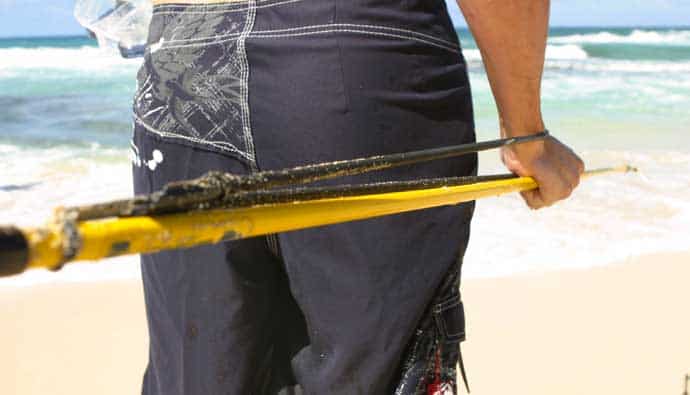
They tend to be less powerful than a speargun since you have to get closer to the fish to shoot.
This means there is less chance that you’ll overshoot a fish far and hit your dive buddy and injure them…plus you should never have a spearo in front of a loaded weapon, but sometimes people are careless.
Spears are meant to pierce fish…not your dive buddy.
Pole Spear Features
The best pole spears are simple in operation, but over the past few decades have been innovated to improve their robustness and speed in the water to help you catch more fish.
We’re going to break down the different features that are important for you to consider when you’re buying a pole spear based on your specific criteria.
Pole Spear Balance

For a pole spear to hit a fish, it must be accurate, and this is achieved by designing the right center of balance into the pole spear.
Think of a broom. When you are able to balance it on your finger, the placement of your finger on the pole is its center of balance.
For most pole spear designs, the weight will be located in the first one-third of the spear to keep it from yawing when shot.
Think of an arrow when it leaves a bow, the weight is in the front because the weight in the front will guide the flight path and the back of the arrow will follow.
For a great breakdown of the physics of a pole spear, be sure to check out this article by Linghunt.
Pole Spear Lengths
This comes down to what conditions you’re using the pole spear in. The rule of thumb is that you should use one that’s at least seven feet long to give you a wide range of situations to hunt with.
Anything smaller, and it might be too weak to hit meaningful fish.
If you’re in blue water situations, bigger tends to be better, so you can load up more power and hit from further away. Eight to nine feet would suffice.
Pole Spear Materials
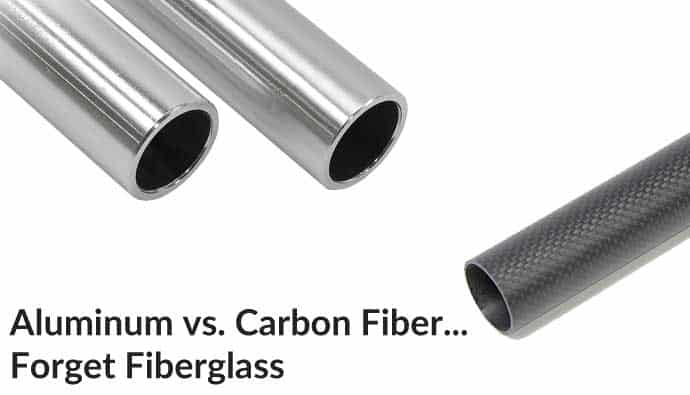
Pole spears can be made out of a variety of materials, but the common ones are fiberglass, carbon fiber, and aluminum.
Fiberglass Pole Spears
Fiberglass tends to be the cheapest of the bunch, and I recommend you stay away from them. They aren’t as robust and will not survive the beating of reefs and rocks.
Fiberglass isn’t as stiff as other materials, so you will get a lot of flex in the pole, which will take away from the power transfer and potential accuracy of the shot.
A two-piece fiberglass pole spear will add some extra stiffness and reduce flex, however for longevity, it’s still better to switch to a better material.
Many spearos claim to see the remains of these typically yellow fiberglass pole spears at the bottom of the reef…
Carbon Fiber Pole Spears
Carbon fiber is an extremely strong material that has a tensile (pulling) strength greater than steel. Therefore, when it’s manufactured, this material is placed at various angles of fiber directions and bonded together by a strong epoxy.
This means that you get a strong pole spear at a fraction of the weight. They also tend to be stiff depending on how the layers are constructed, which will reduce flex.
All of this translates to a quick pole spear in the water. There are also hybrid designs that have certain areas as metal and others as carbon fiber to get the benefits of both worlds.
Some spearos have problems with carbon fiber because they tend to get beat up pretty badly over time when you hit reefs and rocks.
They also have a downside for not having enough punching power to take down big fish.
If you need a quick quiver that will keep them away from point-blank blasts against hard objects, they are a great choice.
Aluminum Pole Spears
Aluminum is a great material to make pole spears because they have the weight to provide stopping power for big fish and can take the abuse of rocks and reefs.
This added weight can make them a bit slower in the water, which tends to be a common complaint by spearos.
It’s hard to hit fish if you can’t get your pole spear lined up in time and unloaded. Many manufacturers do their best to shave off as much material as possible to give the pole spear enough stiffness for an accurate shot and light enough to not feel like a rock in your hands.
Most polespears are anodized, which gives them added corrosion resistance in saltwater and can further add to the stiffness.
Pole Spear Grips
Pole spears come with a wide variety of grips, from barebone to complex. Many of the cheap fiberglass versions don’t have a grip, which makes it difficult to hold underwater when loaded.
Manufacturers have their own styles, from a spiral shape to ridges and tapers. This all comes down to the personal preference of the diver.
The taper is a nice design because it allows for a variety of grip positions, whereas the spiral and ridge designs are dependent on which those grips are placed.
An added benefit of having a bumpy grip is that when the pole spear travels through the water, they create air bubbles which in turn form a boundary layer to help reduce friction.
This means more energy will be transferred to the fish and give the spear more stopping power.
If this is hard to visualize, think of a golf ball. The dimples do the same thing and allow the golf ball to travel farther than if the ball was smooth.
Rubber Bands
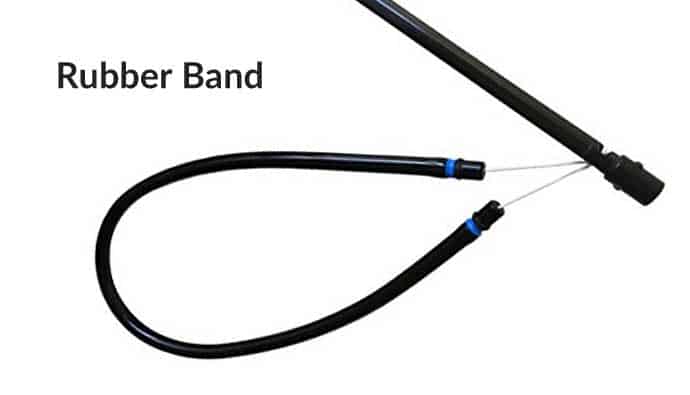
Rubber bands are used as the spring to store energy to fire the spear. If you choose to use a thicker rubber band, you’ll get more power transferred to your spear and visa versa.
However, if you use too powerful a band, you’ll put more stress on the pole and might cause excess flex that could affect your shot…plus it might be too hard or tiring to use for the whole day.
Depending on where you’re shooting, it’s important to vary the amount of energy you transfer to the spear to not damage it. If you’re in the open water, you want the max power because the fish are larger and you probably need to shoot farther.
Many rubber bands are fixed at the end of the pole spear, which limits your options for adjusting power.
Some higher-end pole spears have a cam that allows you to move the rubber band closer to the tip of the spear to give you added flexibility around hard objects like reefs.
Remember, try not to overshoot your fish so you can keep your pole spear in working order for longer.
Pole Spear Tips
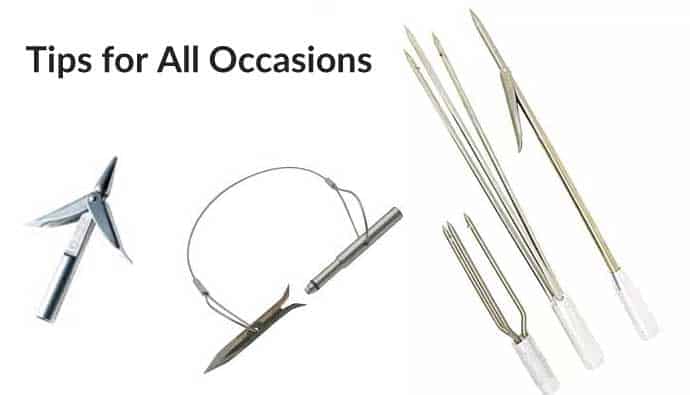
Prong Tips
Pole spear tips come in a variety of shapes and sizes depending on your needs. The most common styles are prongs which usually have three or five spears. When they enter the fish, they spread out, preventing the fish from getting away.
There is a higher cross-sectional area on a prong tip which adds drag to your spear. You’ll tend to use this style for reef fish, where you don’t need much spear travel. These are also good for smaller fish.
Flopper Tips
These are the same as the tips commonly found on spearguns. They come in either single or double floppers, depending on how much staying power you need for the fish species.
Floppers work by entering the fish, and when they swim away, a piece of metal opens up and prevents the spear from exiting the wound. These have a low profile through the water and tend to make the pole spear quicker than prong-style tips.
This also means that the spear needs less mass for the same amount of damage, which is why you see this tip on more high-end pole spears.
Slip Tips
Slip tips are beneficial to help keep fish with softer flesh on the end of your spear after being hit. The tip of the spear detaches and is held in place by a cable or Dyneema cord so that it provides more give with the fish’s movements.
These tend to be used on big fish in open water.
Breakaway Tips
Breakaway tips are similar to slip tips, except they are anchored directly to a mechanism that releases the tip away from your gun and onto your floatline. This is a must for big-game fishing if you don’t want to risk losing your pole spear.
Simply spear the fish and let the fish run and pull on the float line and float until it’s tired, then bring it up to the surface. Simple, right?
Pole Spear Float line
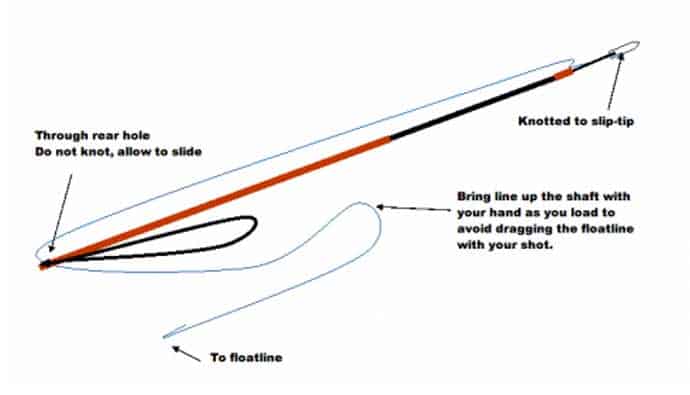
Most of the time, you won’t need a float line when using a pole spear unless you go for large fish. Since the newer pole spears are becoming as effective as spearguns, you’re starting to see the use of float lines and floats more often in blue water videos.
Pole spear float lines act the same way as speargun float lines. You’ll attach the float line to the end of your pole spear, and after you hit the fish, you let your pole follow the fish and let the fish fight the buoy or boat.
If you don’t want to risk your pole spear to the sea gods, buy a breakaway tip and let the tip connect directly to the float line.
Do It Yourself (DIY) Pole Spear
For those of you who are adventurous or crafty, there is always the option to build your own pole spear. Here are a few videos I found online of guys doing just that.
Also, if you want a custom spear, check out the fine individuals over at LingHunt who let you specify exactly the pole spear you want based on your needs.
How to Care For Your Pole Spear?
Pole spears are simple in their design, which makes them easy to care for. The main areas of care will be the rubber bands and the tips, which get the most use.
For the rubber bands, make sure you keep them out of the sun when not in use. Over time they will dry out, so you’ll need to replace them when you see cracking.
If you’re not going to use your pole spear for a while, take off the rubber band and place it in a plastic bag in your fridge to help it last longer.
The tips will get the most abuse because they hit hard objects like reefs and rocks. If that doesn’t do them in, over time, they’ll develop rust unless their stainless steel.
Always have a bunch of tips in your arsenal so you can switch them out if damaged or switch them out depending on the conditions.
After using the pole spear for the day, it’s probably better that you take it apart if it disassembles, rinses it under fresh water, and let it dry in a dark place.
Pole Spear Buyer’s Checklist
- Get a pole spear that is at least two pieces.
- Opt for aluminum or carbon fiber instead of fiberglass. Pick aluminum if you need robustness and carbon fiber if you need speed.
- I recommend at least 7 feet for your pole spear.
- Do your best not to hit reefs or rocks at full power.
- If using carbon fiber, be careful pulling the spear with a force that bows the material. This could lead to breakage.
- Replace rubber and tips when necessary.
- Disassemble and rinse with water after use and store away from extreme heat or direct sunlight.
Insider Advice
The cheap yellow fiberglass pole spears tend to be poorly constructed, and you’ll most likely be replacing them within months. Do your future self a favor and spend some money on a better model upfront so you can master a spear you’ll use for years.
You might be asking, what is the best pole spear available then? And I’m sure you know my response…
It depends.
There are many factors that go into this decision, such as what type of fish you are going for, are you in open water or near a reef, what’s your skill level, etc.
More than One Pole Spear
One thing’s for certain; it’s best you have multiple quivers in your arsenal. That’s the only way you could make sure to have the right tool for the job. This is especially true when you’re on a dive trip.
The last thing you want is a busted pole spear, and your trip is ruined because you can’t get another one in time.
Pole spears also seem to be having a revival in the community, and there are some amazing manufacturers that don’t get enough love. I want to change that so you can get a clear picture of all the latest innovations available for you to try out.

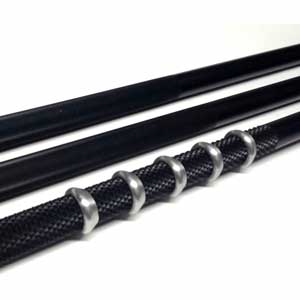



 Facebook
Facebook YouTube
YouTube